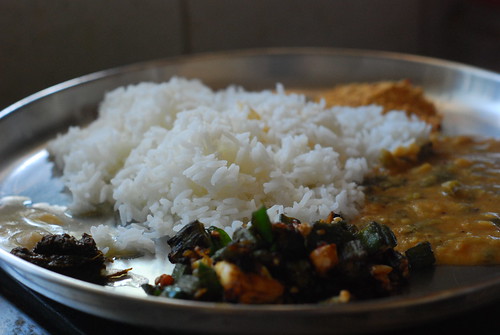I ride a bicycle and run off-road a lot and sometimes I'm gone for hours at a time. Here in India, usually I can find a village with someone selling bananas and water, but if you want something more substantial and with more complex carbs your choices in most small villages are limited to some really bad options:
chikki (peanut brittle)
peanuts (not always available)
glucose biscuits (full of hydrogenated fats and of course, sugar)
Last time I was in the US I brought back a couple boxes of Clif bars, and I was really enjoying them for a change. I'm nearly out of them, and I am not going to the US soon, so I thought I'd make them. I found a reasonable recipe here.
The problem is that it calls for brown rice syrup and I have not been able to find that in my stores. I did however, run across date syrup and it makes a reasonable substitute.
I have made it with rice puffs (bhel churmura) and with standard (unsweetened) corn flakes. While it comes out denser with the cornflakes, I prefer it.
1.25 cups crisp rice puffs or corn flakes
1 cup uncooked quick-cooking oats (Bagry's works fine)
2 tablespoons ground flaxseed (optional but supposed to be good for you says my wife)
1/4 cup finely chopped dried fruit (seedless raisins, dried figs, dates, etc.)
1/4 cup finely chopped nuts or seeds (almonds-badam, ground nuts, or cashews to your taste)
1/3 cup date syrup
1/2 cup groundnut butter (unsweetened, home made if possible)
1 teaspoon vanilla extract (again, optional)
1) Combine the rice or cornflakes, oats, flaxseed meal, dried fruit, and nuts in a large bowl.
2) Combine the syrup and nut butter in a small saucepan over medium heat, stirring until melted and well-blended (alternatively microwave in small microwave-safe bowl 30-60 seconds until melted). I bring it to a full boil, but I'm not sure that is necessary. Stir in vanilla until blended.
Now, I found that if I let this mixture cool even just a little, it will start to crystallize. So I try to work quickly and do the next step right away.
3) Pour the hot nut butter mixture over cereal mixture, stirring as well as you can until coated (use a wooden spoon at first, then get your hands in it after it cools enough. It will be sticky, but it's not too bad. Just wash your hands when you're done).
Once it's thoroughly mixed (doesn't have to be perfect) it's time to make the bars.
Oil a square pan (20cm x 20cm approx) lightly with peanut or other flavorless oil (not olive) so the bars won't stick.
Turn out the mixture into the pan and press it down. I use the bottom of a drinking glass to get a smooth surface that I can get some pressure on. The harder you press, the denser the bars will be but the better they'll stay together. It's your call.
Put the pan in the refrigerator for a while to help the bars set, then cut out the 8 bars.
Wrap them each in plastic wrap or put them in small plastic bags in the fridge.
According to Calorie Count, these come out as follows assuming rice syrup is similar to date syrup:

These are higher in fat than clif bars, and I think you could cut back the peanut butter and replace it with more date syrup if you like. If you did this:
1.25 c puffed rice
1c quick oats
1/4 c raisins
1/4 c almonds
1/2 c rice syrup
1/4 c natural peanut butter
You'd land with the following, which looks a bit better to me, though I haven't tried making them this way:

Let me know if you try to make these, and if you have success with alternative additions.
The nutrition info comes from here: http://caloriecount.about.com/




















